Slow Cognition: The Echoes of A Thematic Dialogue
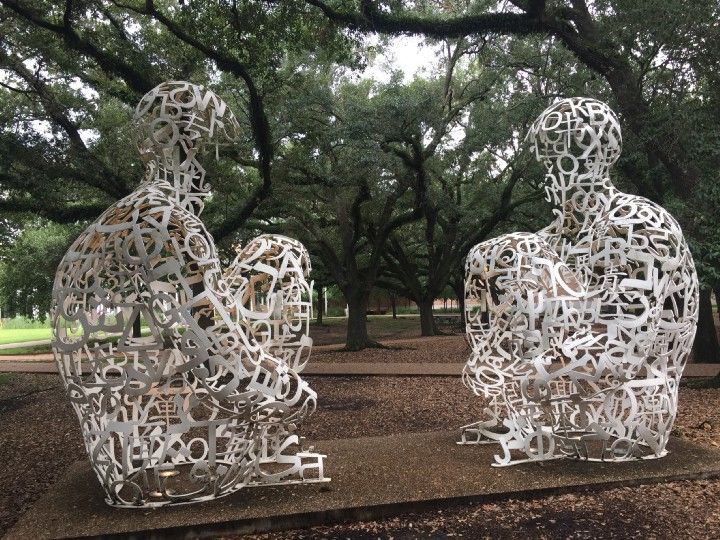
On Sept 15, 2022, I launched the Thematic Engagement Toolkit (v1.0) which is for understanding knowledge engagement, thematic conversation, controversy, thematic reflection, etc. The toolkit refers to a dialogue between the following two knowledge frameworks:
1. The Themes of Practice Approach (2019, 2021)
2. The Project Engagement Approach (2021, 2022)
In fact, this is a milestone in my journey of "Activity - Opportunity" Thematic Dialogue.
I used the diagram below to represent the second-wave development of the about two approaches. There is one "ECHO" in 2021.

In fact, there are several "ECHOes" that led to the final closure. Today I'd like to share more details about these ECHOes.
Contents
- What's ECHO?
- An Emerging Thematic Dialogue
- ECHO 1: The "Hierarchy" of Human Activity
- ECHO 2: “Formation of Concept” and “Themes of Practice”
- ECHO 3: The "Themes of Practice" Framework
- ECHO 4: Rethinking Activity Theory
- ECHO 5: Controversy Mapping and The Thematic Controversy Project
- ECHO 6: Grow A Knowledge Enterprise
What's ECHO?
The term "ECHO" refers to the ECHO way which is a book (draft) and a framework.

The ECHO Way is about fit between individual and environment. Where is the fit? It happens at the “Echozone” which is the third container of the following model.

The concept of Container is the core of the Ecological Practice approach. By adjusting the quality and quantity of the Container, we can create advanced frameworks for discussing complex phenomena. The quality of the Container can be potential and actual, and the quantity of the Container can be one or two. If we develop a new framework with one potential container and two actual containers, the outcome is the above diagram.
I named the potential container (Container Z) as Echozone which refers to a creative space containing echoes between Container X and Container Y.
The term “Echo” of “Echozone” refers to a connection between two containers. The connection may lead to a significant insight. It may change Container X or Container Y. The "Echozone" may produce something new beyond X and Y.
An Emerging Thematic Dialogue
I have claimed that the Thematic Engagement Toolkit (v1.0) is an outcome of a thematic dialogue between "Themes of Practice" and "Project Engagement".
However, I didn't plan the thematic dialogue. The thematic dialogue is an emerging process.
Also, there are more echoes that impact the notion of "Thematic Engagement".
"Themes of Practice" and "Project Engagement" are not the only two sources of the final outcome. See the diagram below.
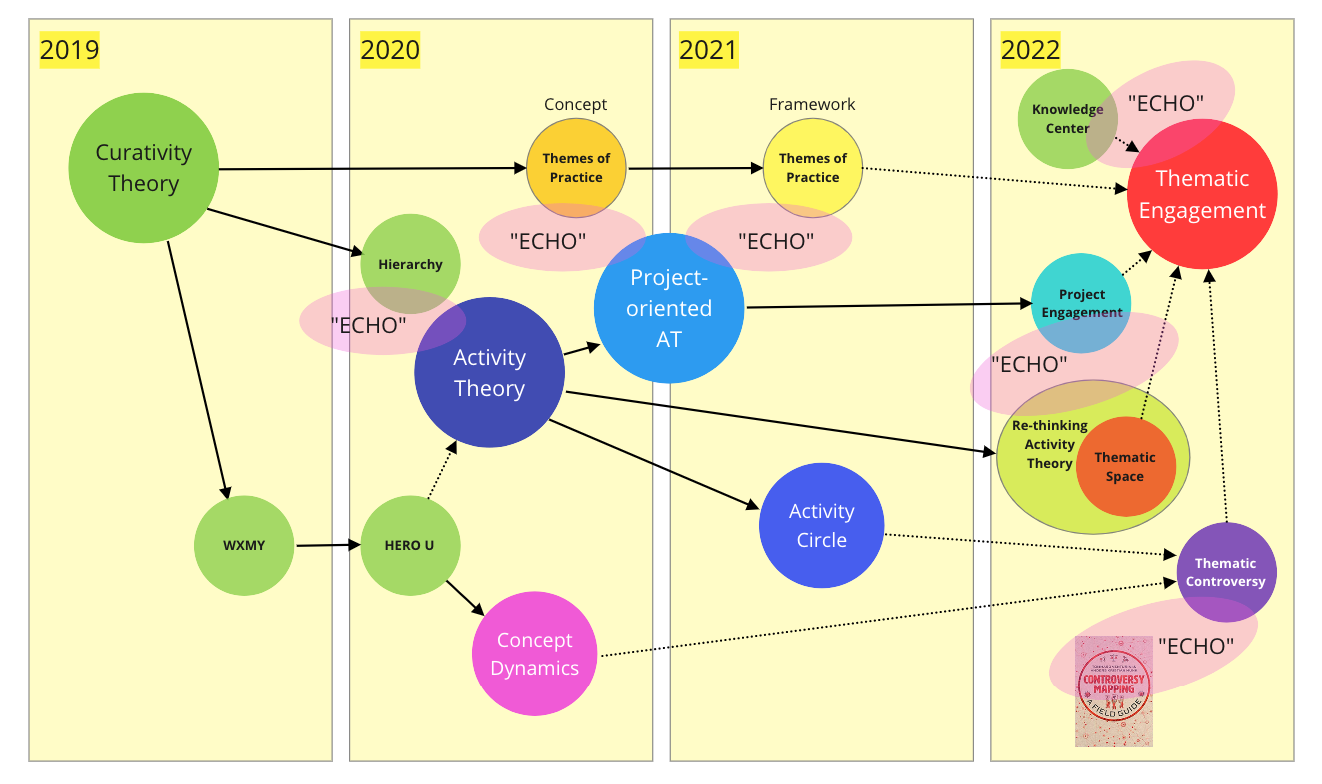
The above diagram shows the following five Sources that led to the notion of "Thematic Engagement".
- Themes of Practice
- Project Engagement
- Thematic Space
- Knowledge Center
- Thematics Controversy
From 2019 to 2022, there are six ECHOes between these five sources. The rest of the article will offer more details about these ECHOes.
- Sept 29, 2020 - Echo 1: The "Hierarchy" of Human Activity
- Dec 26, 2022 - Echo 2: “Formation of Concept” and “Themes of Practice”
- April 2021 - Echo 3: The "Themes of Practice" Framework
- July 20, 2022 - Echo 4: Rethinking Activity Theory
- July 31, 2022 - Echo 5: Controversy Mapping and The Thematic Controversy Project
- Sept 6, 2022 - Echo 6: Grow A Knowledge Enterprise
If we see these echoes as a meaningful whole, we can call it a thematic dialogue.
ECHO 1: The "Hierarchy" of Human Activity
On Sept 29, 2020, I wrote a long article titled Activity U (VI): The Hierarchy of Human Activity and Social Practice.
The article is part of the Activity U project. I used a pattern for the project: HERO — IDEA — OTHER— ECHO. Each time I focus on an activity theorist (HERO) and one related notion of activity theory (IDEA), I then expand the scope of discussion by adding related resources from other activity theorists and other disciplines (OTHER), I also share my own experience and reflection on some topics (ECHO).
In this article, I met the first ECHO between Activity Theory and the concept of "Themes of Practice" which is part of Curativity Theory.
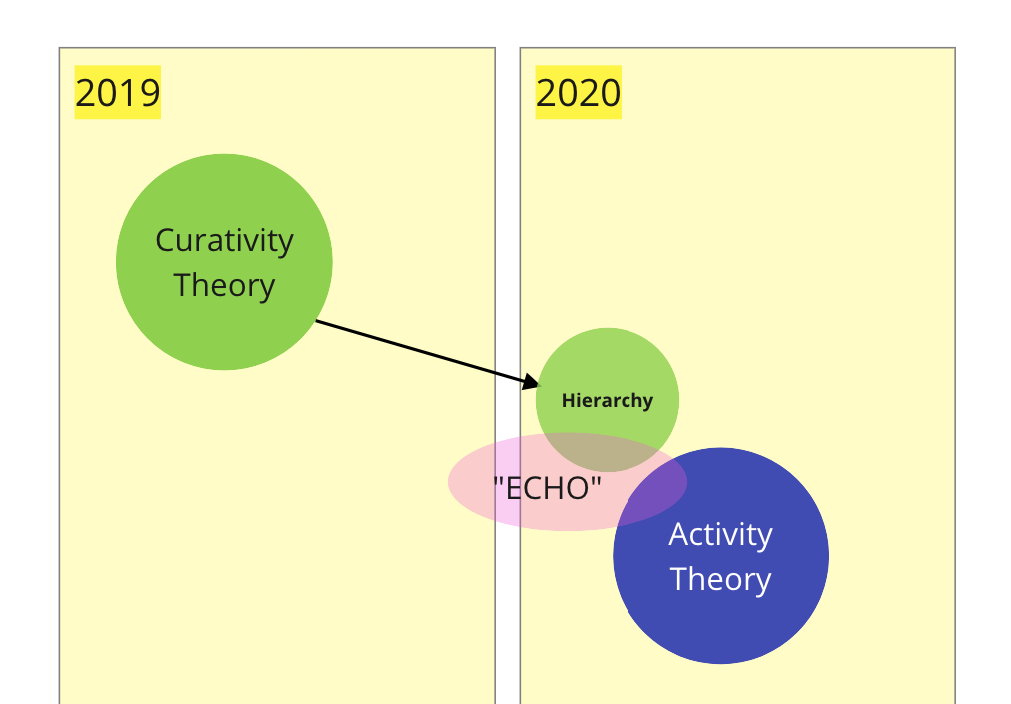
Activity Theory or the “Cultural-historical activity theory (CHAT)” is an interdisciplinary philosophical framework for studying both individual and social aspects of human behavior.
The hierarchical structure of activity was originally conceptualized by A. N. Leontiev (1978). The three levels of activity are activity, actions, and operations. The three levels of psychological notions are motive, goals, and conditions.
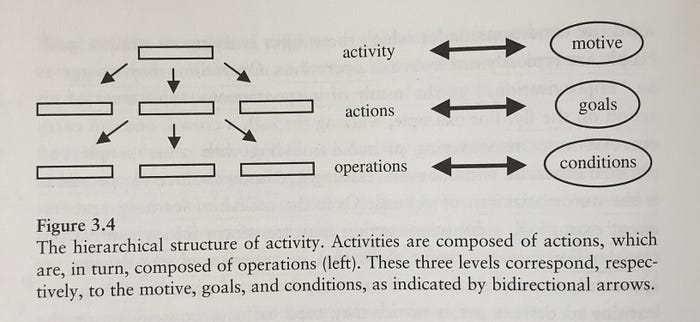
Human activity and social practice are extremely complex, the hierarchy is a great thinking tool for understanding them. I also reviewed the "Hierarchy" aspect of social practices from perspectives of other theoretical approaches.
Based on perspectives from activity theorists and other researchers, I found there is an eight-level hierarchy of activity and practice. The six mid-levels are adopted from activity theorists. The top-level is adopted from anthropologist Morris Opler (1945). The low level is adopted from ecological psychologist James J. Gibson (1979). See the table below.

It depends on the needs of theoretical development and empirical research. Thus, I call the new hierarchy as “a universal hierarchy of activity and practice” in which I use “activity” as a regular word, not the concept of activity theory.
What I learned from this first ECHO is the "Hierarchy" of human experience. If we want to find a concept that could unite several Activities as a meaningful whole, the 'Themes of Practice" is a good option. However, this is not the "unit of analysis" of Activity Theory.
You can find more details in Activity U (VI): The Hierarchy of Human Activity and Social Practice.
ECHO 2: “Formation of Concept” and “Themes of Practice”
On Dec 26, 2020, I wrote a long article titled Activity U (VIII): Project as a Unit of Activity.
This article is the first article about Andy Blunden’s project-oriented theoretical approach. In Jan 2021, I wrote more articles about the approach and edited a book titled Project-oriented Activity Theory.
In Part 4 of the article, I reflected on my own works and discovered connections between the approaches and my ideas.
I found that I can adopt Andy Blunden's notion of "Formation of Concept" to support my idea of "Themes of Practice". This is the second ECHO.
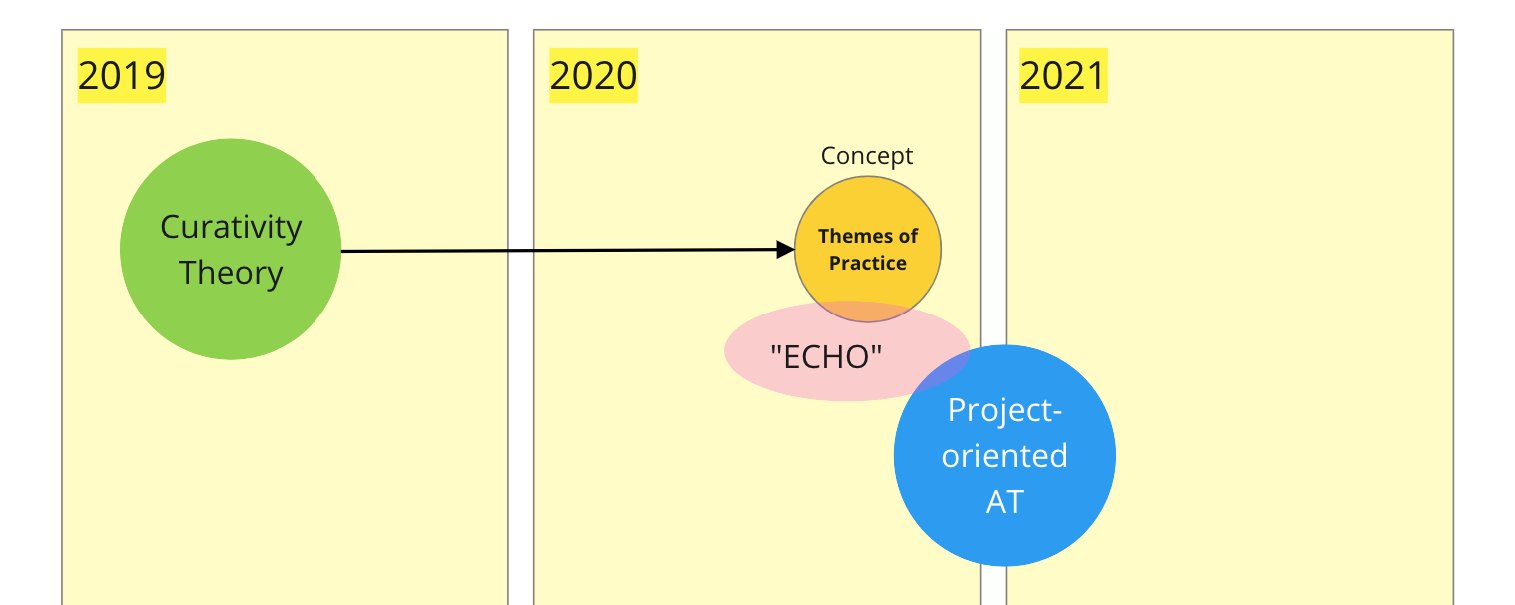
After reviewing the concept of “theme” in various disciplines such as Cultural Anthropology, Counseling Psychology, Cognitive Psychology, and the Philosophy of Science, I developed a new concept “Themes of Practice” to propose a process view of “Theme”.
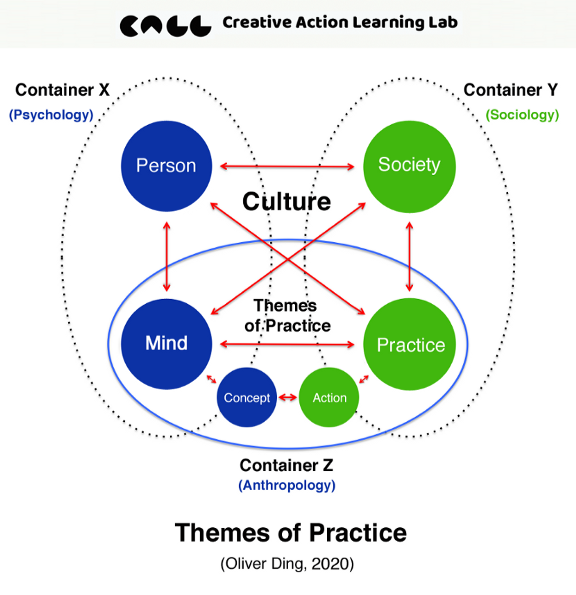
Anthropologist Morris Opler (1945) developed theoretical “themes” for studying culture. Career counseling therapists and psychologists also developed a theoretical concept called “life theme.” If we put culture themes and life themes together, we see a “great debate” of social science: “individual — collective.” The above diagram visualizes the “concept network” or “idea ecology” of “Themes of Practice”.
I consider the notion of “Themes of Practice” as a “process” type of concept, not a “substance” type of concept. Thus, it is not a new category of themes, but a transformational process between individual life themes and collective culture themes. It refers to both concept and action. It connects mind and practice. It indicates the transformation of both person and society.
After reading Blunden’s book Concepts: A Critical Approach which presents a “Hegel-Marx-Vygotsky” account of “Concept”, I realized this is an essential theoretical resource that can support my idea of “Themes of Practice”. According to Blunden, “Dualism has been around for a long time, and not only in the form of mind/matter dualism. One of the most persistent and debilitating forms of dualism today is the dualism of the individual and society, supported by sciences devoted exclusively to one or the other domain. Since concepts are units both of cultural formations and individuals minds, a theory of concepts confronts this head on…The development of the human sciences along two parallel paths, one concerned with human consciousness, the other concerned with social and political phenomena, can only serve to place barriers in front of people’s efforts to intervene in the affairs determining their own life. By understanding concepts as units of both consciousness and the social formation, I aim to create a counter to this disempowering dogma.” (2012, p.9)
Blunden’s argument on Concept echoes my consideration of the concept of Theme. Since Theme is a particular concept, I can adopt Blunden’s proposal — the “Hegel-Marx-Vygotsky” account of “Concept” — as a theoretical foundation to support the concept of “Themes of Practice”. Furthermore, I can also adopt the Project-oriented Activity Theory to upgrade the General Curation Framework to Cultural Curation Framework.
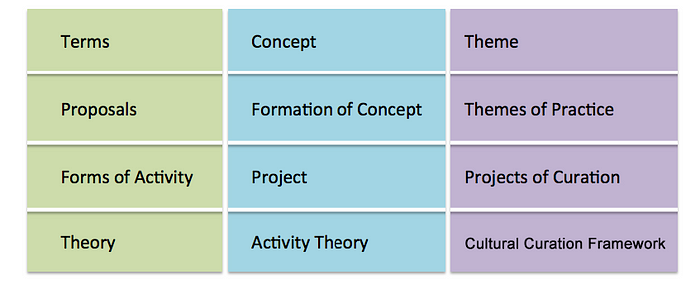
Each curation program can be considered a Project. Each “Theme of Practice” of a curation program can be considered as a Concept of a Project. Thus, the whole process of a curation program can be considered as “Initialization”, “Objectification” and “Institutionalization” of a “Theme of Practice”.
You can find more details in Activity U (VIII): Project as a Unit of Activity.
ECHO 3: The "Themes of Practice" Framework
In April 2021, I started learning Genre Theory. I designed a new diagram for Themes of Practice and shared it on Twitter for discussing Genre Theory. At that time, I didn’t realize that the new diagram offers me a concrete framework for analysis.
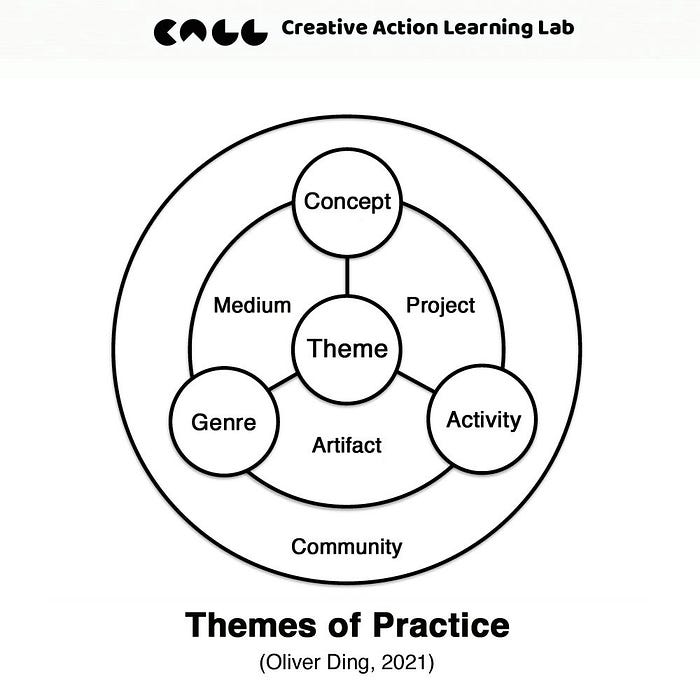
In June 2021, I started the Career Curation project. I applied the idea of Themes of Practice to generate a new concept: Career Themes. It means that I move from an abstract level to a concrete level. Thus, I realized I can use the new diagram for the career theme case study because it offers a structure for observing and evaluating the “Practice” part of “Themes of Practice”.
Later, I named the above diagram the "Themes of Practice" framework. If you pay attention to the diagram, you will find several sub-dimensions. For example, "Concept", "Project", "Activity", etc.
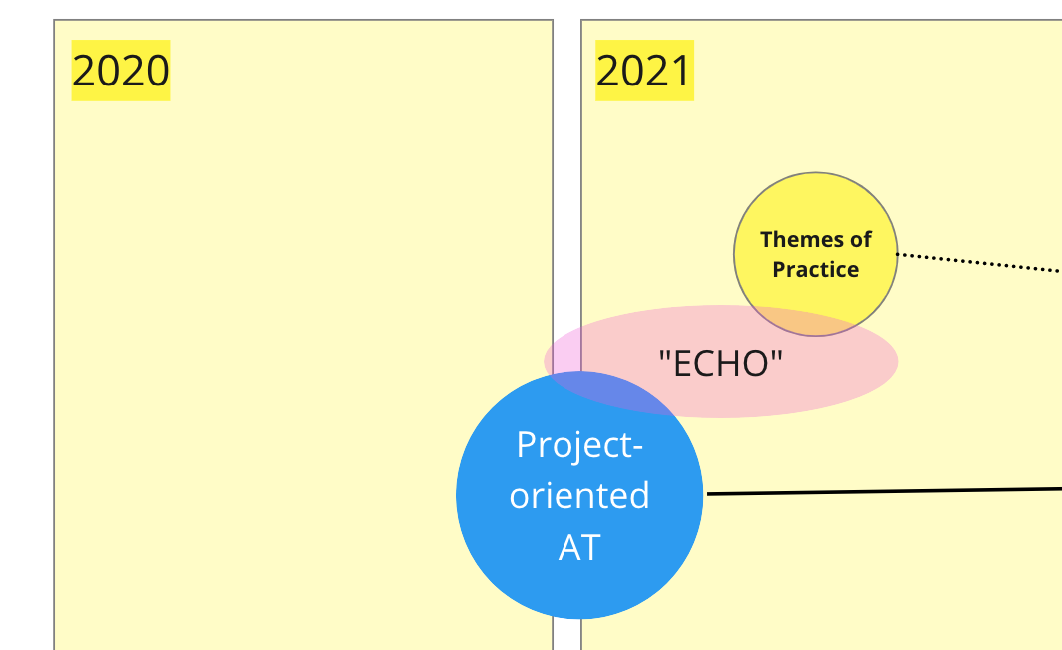
We should notice that I use "Concept", "Project" and "Activity" as Operational Concepts for the Themes of Practice framework. However, I also used Concept Theory, Activity Theory, and Project-oriented Activity Theory as theoretical resources for the framework.

This is the third ECHO between the Project-oriented Activity Theory and the Themes of Practice framework.
You can find more details in Themes of Practice (2019–2021).
ECHO 4: Rethinking Activity Theory
On June 27, 2022, I wrote a note titled Re-learning Activity Theory.
In the past two weeks, I returned to theoretical learning of Activity Theory.
Why?
There are three things behind this move: 1) Last week the AAS4LT program roughly closed its first part: Life Discovery Project, 2) I am reading a book titled The Scientific Project of Sociology, and 3) I am also reading a book titled Controversy Mapping.
All these things encourage me to re-read papers about Activity Theory and rethink it and my creations about it.
On July 20, 2022, I started writing an introduction to the Project Engagement approach (v2.0) in Chinese. The thesis was finished on July 30, 2022.
The thesis was organized into the following five parts:
- Part 1: Project, Projecting, and Activity
- Part 2: Significance
- Part 3: Complexity
- Part 4: Genidentity
- Part 5: Rethinking Activity Theory
Part 5 of the thesis is the outcome o re-learning Activity Theory. I discovered the following pairs of keywords for discussions:
- Concepts and Themes
- Project and Platform
- Culture and History
- Context and Settings
Finally, I made a "meta-framework" for the Project Engagement approach (v2.0). See the picture below.

The meta-framework is formed with two sets of keywords:
- Activity, Concept, Culture: this set of keywords is discovered from Andy Blunden's approach.
- Actor, Settings, Society: this set of keywords is discovered from the Project Engagement approach.
This is the fourth ECHO of the two approaches. The concept of "Thematic Space" is new to both the Project Engagement approach and the Themes of Practice approach.
See the diagram below.
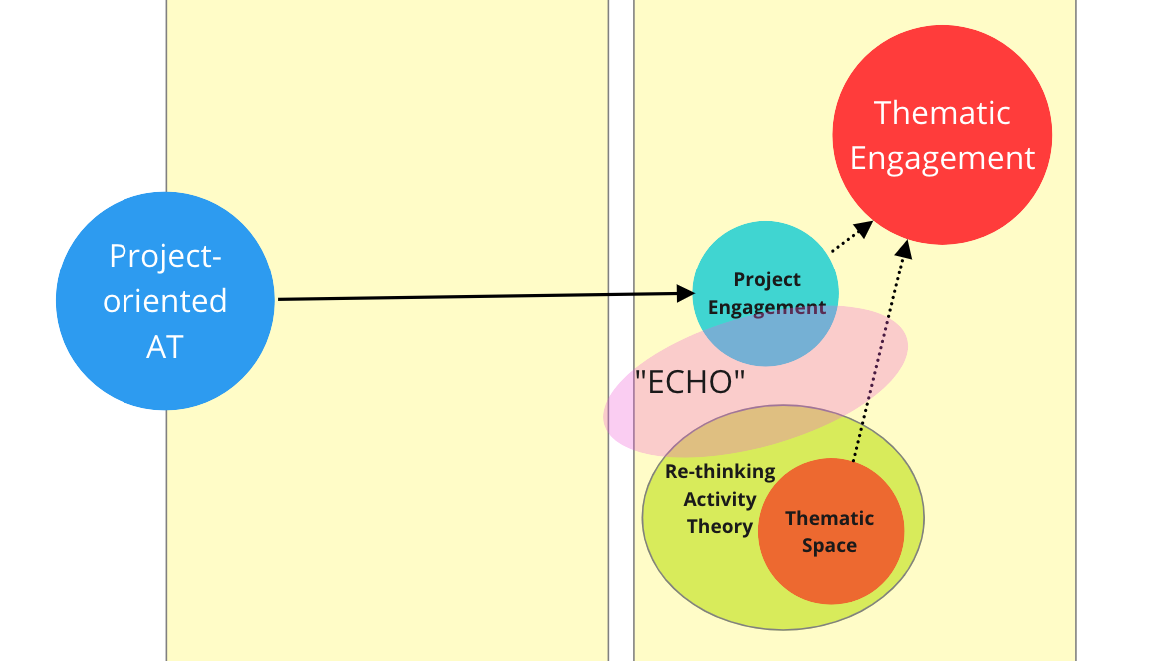
The outcome is a major update of the Project Engagement Approach. You can find more details in Project Engagement (v2): Life, History, and Multiverse and Project Engagement (v2.1) as an Innovation Approach.
ECHO 5: Controversy Mapping and The Thematic Controversy Project
In June 2022, I read Controversy Mapping: A Field Guide (Tommaso Venturini & Anders Kristian Munk, 2022) which connects ANT (Actor-network theory) with digital methods for social cartography.
The authors combine two different but related schemas — the “actantial model” (proposed by Greimas, 1966, to categorize actors) and the “canonical narrative schema” (proposed by Greimas, 1970, to categorize action) — to suggest a way to dissect collective “programs of actions” into their components.
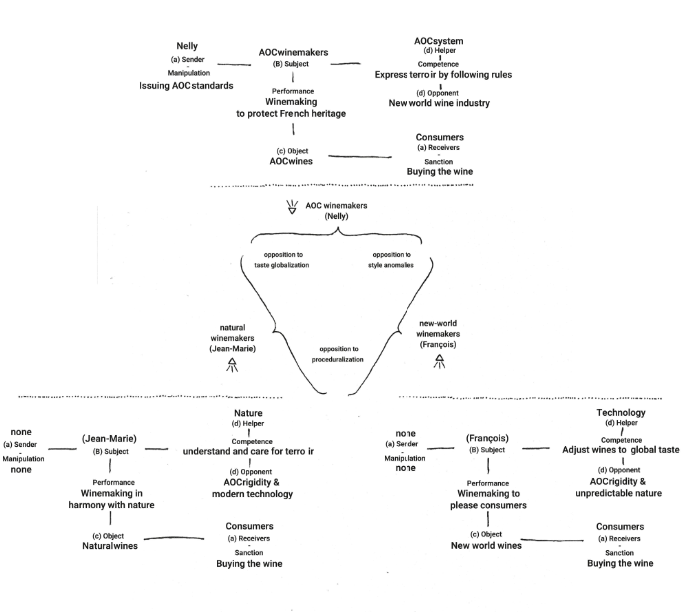
The authors use a story about French wine and terroir as an example to show the power of the method. You can find a large-size picture of the above diagram here. You can also find more details about the two schemas in the following articles:
I have read the diagram many times. On June 27, 2022, I realized the above diagram is an example of Diagram Blending and I can use the pattern to blend two of my diagrams together.
- Concept Dynamics
- Activity Circle
These two diagrams and frameworks are not part of the Project Engagement approach and the Themes of Practice framework. However, they led to the idea of "Thematic Controversy" which is an inspiration for the notion of "Thematic Engagement".
This is the fifth ECHO.

Why do I want to blend the Concept Dynamics framework and the Relevance of Zone model together?
In June and July, I noticed that there is a pattern behind many discussions on Linkedin. These discussions always present a theme-centered conversation or controversy.
I also realized that the Concept Dynamics framework and the Relevance of Zone are suitable for mapping these discussions.
You can find more details in Diagram Blending: “Activity Circle” + “Concept Dynamics”.
ECHO 6: Grow A Knowledge Enterprise
On Jan 13, I designed the diagram below to visualize what I talked about the notion of Knowledge Center with my friend on Jan 2.
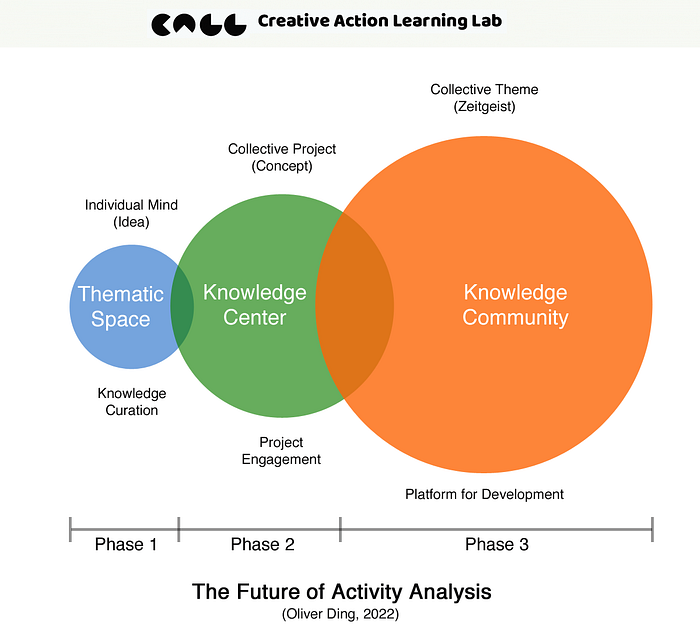
The above diagram describes an imagined project with a new concept.
- An imagined project: the Activity Analysis project
- A new concept: Knowledge Center
On May 6, 2022, I published an article titled CALL: How to Grow A Knowledge Enterprise and use the above diagram to develop a model for Building A Knowledge Enterprise.
From May to the present, the concept of the "Knowledge Center" became the primary focus of my creative activities.
This is the Sixth ECHO of the two approaches. See the diagram below.
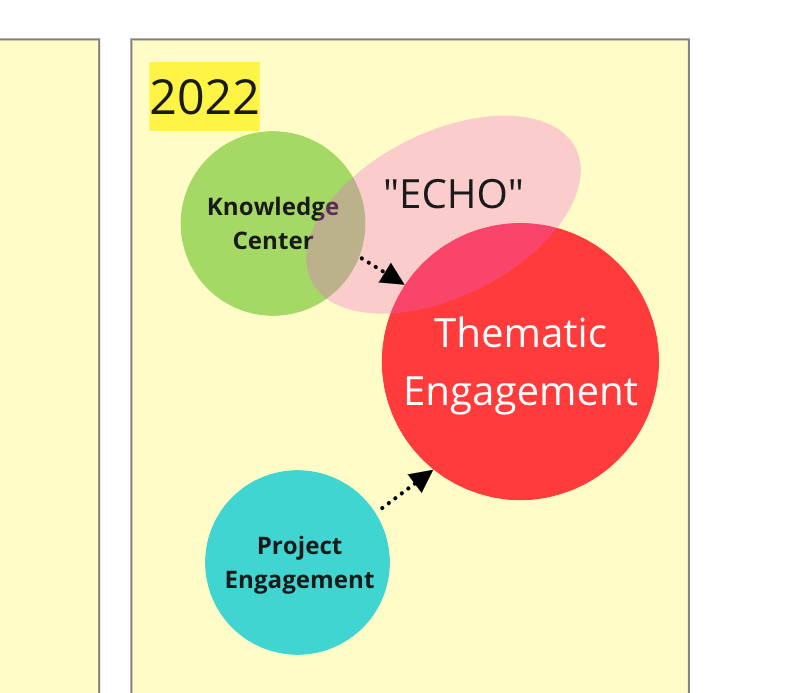
The Activity Analysis project is a website that refers to my “Activity” thematic space. The website is just about an idea that belongs to an individual mind.
In the next phase, the Activity Analysis project is expected to grow as a knowledge center as a collective project. That means it is not my personal idea, but it should be a concept shared by a group of people who are passionate about adopting the “Activity” thematic space for their epistemic development. Also, they would like to contribute to the development of the collective “Activity” thematic space.
Phase 3 is building a Knowledge Community. The difference between Knowledge Center and Knowledge Community is Scope and Scale. A knowledge center may only have less than 15 members while a knowledge community may have thousands of members.
The three-phase development is inspired by Project-oriented Activity Theory.
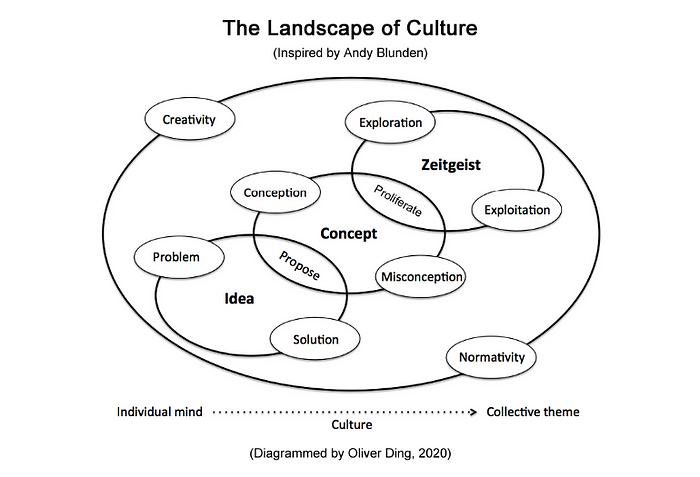
I used the above diagram to explain the concept of “culture” from the perspective of Project-oriented Activity Theory. It zooms out to a large view that connects the Individual mind (Idea) and Collective theme (Zeitgeist) through Collective Projects (Concept).
The about diagram also mentions three knowledge frameworks I am working on:
Each knowledge framework could be adapted to support one phase of the Activity Analysis project. The Knowledge Curation framework is for the development of the “Activity” thematic space (phase 1). The Project Engagement framework is for the development of the “Activity” knowledge center (phase 2). The Platform for Development framework is for the development of the “Activity” knowledge community (phase 3).
From the perspective of Project-oriented Activity Theory, there is a new Concept called Knowledge Center behind the Activity Analysis project. It means that the Activity Analysis project is the demo of the concept of the Knowledge Center.
On Sept 6, 2022, I sent an email to a friend and the email's subject is Thematic Engagement.
...
In July, I expanded the Project Engagement approach to a new version and introduced some new modules such as Project Network, and Thematic Space.
I also slowly moved to real applications of the Project Engagement approach. I selected Knowledge Creators as the target audience because my approach considers "Activity=Concept/Theme=Project". Since Knowledge Creators' products are Knowledge that can be understood as themes and concepts, it is perfect to apply the approach to research Knowledge Creators' creative work and life.
I called this application "Thematic Engagement". For example, your work on ... [...]... is a Thematic Engagement around the [...] theme. This direction is also related to my long-term interest in biological research, especially Life Themes and Life Curation.
Last weekend, I developed a new method called "Mapping Thematic Landscape". I also used my "Curativity" thematic landscape as an example to develop the method. While Thematic Space refers to a small scale, Thematic Landscape is a group of Thematic Spaces.
While Thematic Space Canvas focuses on developing Tacit knowledge, Thematic Landscape Map is more about the activity around knowledge themes.
...
On Sept 15, 2022, I launched the Thematic Engagement Toolkit (v1.0). This is the end of the Thematic Dialogue and the beginning of the Thematic Engagement project.
